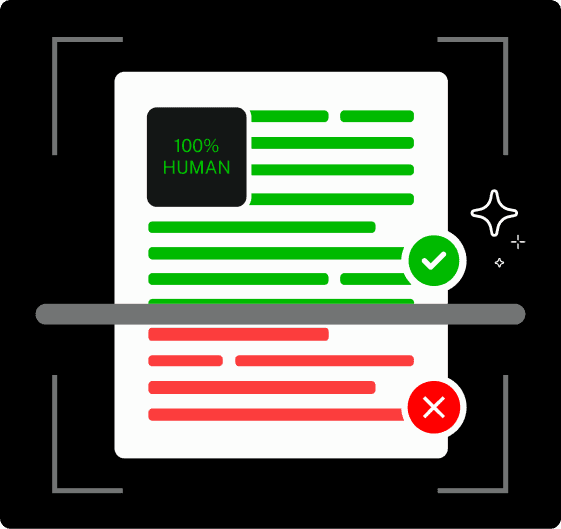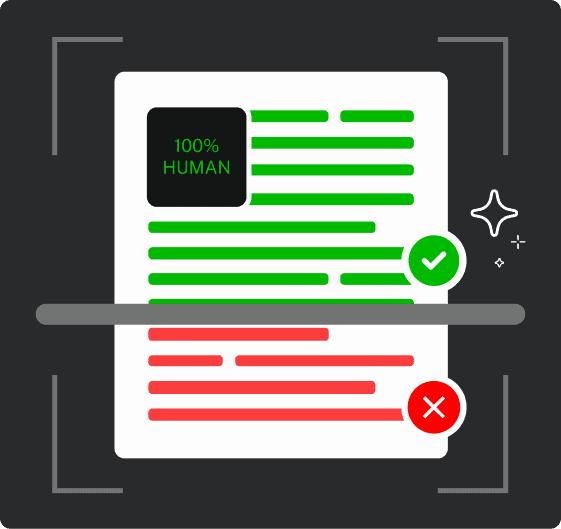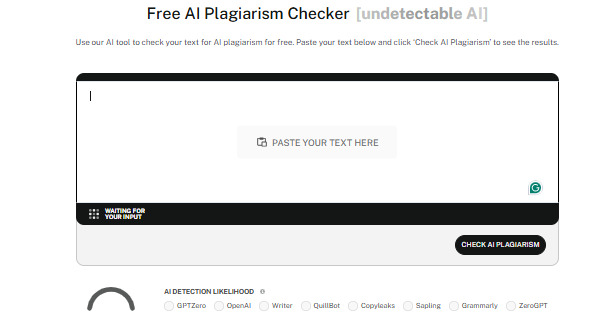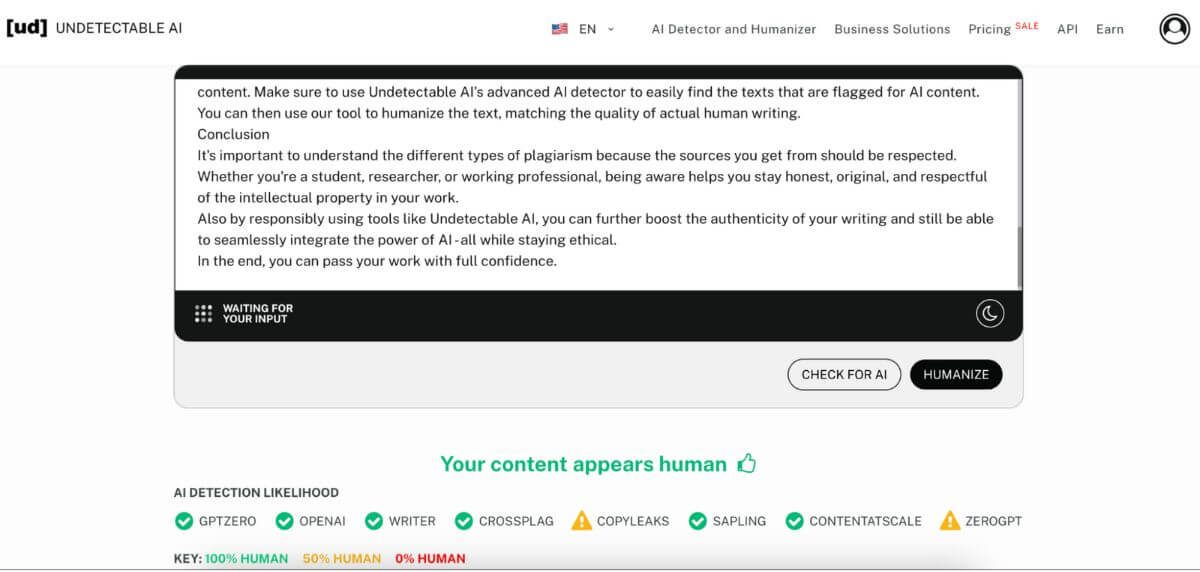Everyone knows that cheating is bad. But that doesn’t stop some from doing it.
More than half of college students even admit to cheating in some type of form. One of the most common types of cheating is plagiarism.
Some people might not even be aware that they are plagiarizing someone’s work.
You might be writing a research paper with the help of AI, but even if you follow what you think is the ethical use of AI in writing, it still gets flagged for plagiarism. What gives?
While it’s clear that plagiarism is copying someone else’s work, there are more subtle things that you don’t expect, which can also count as plagiarism.
It’s time to learn the different types of plagiarism to keep yourself aware of what to avoid and to be more confident in the originality of the works you make.
Key Takeaways
- Plagiarism goes beyond direct copying—forms like paraphrasing, patchwork, and source-based plagiarism can occur even without intent.
- AI-generated content can still trigger plagiarism flags, making it essential to credit all sources and use AI ethically and responsibly.
- Self-plagiarism and accidental plagiarism are often overlooked but can still harm credibility and violate academic or professional standards.
- Proper citation and a deep understanding of borrowed ideas are key to maintaining originality and avoiding intellectual dishonesty.
- Tools like Undetectable AI’s plagiarism and AI detectors help users identify, humanize, and ethically refine content to ensure it’s both authentic and compliant.
Definition of the 7 Most Common Types of Plagiarism
Plagiarism occurs when you use someone else’s ideas, words, or work without giving them credit. You fail to properly acknowledge the original work, and it can be intentional or unintentional.
Why is plagiarism so harmful? The main reason is that it robs the original creators of the recognition they deserve.
In the worst possible cases, this can also lead to legal troubles because it violates copyright laws and intellectual property rights.
Never Worry About AI Detecting Your Texts Again. Undetectable AI Can Help You:
- Make your AI assisted writing appear human-like.
- Bypass all major AI detection tools with just one click.
- Use AI safely and confidently in school and work.
One of the most popular cases of plagiarism is at Harvard University. Almost half of a class of 250 students were suspected of cheating because of similarities on multiple exams.
This resulted in the forced withdrawal of more than 70% of the students involved. This goes to show that even one of the most prestigious educational institutions is not immune to plagiarism.
But beyond the academic consequences, plagiarism also raises some major ethical concerns. Individuals who plagiarize essentially betray the trust of their readers, colleagues, and mentors.
This damages their reputation and even the credibility of the institution they’re in in the long run.
It’s a lot to take in, and it’s even more complicated with the rise of AI.
So, if you’re considering using AI in your college admissions, take a pause and educate yourself first.
Plagiarism is a form of intellectual dishonesty that has many types:
1. Complete Plagiarism
There are different kinds of plagiarism, but this is probably the most common one.
Complete plagiarism completely copies someone else’s work and takes no effort to acknowledge the original creator. That’s it.
This is a type of plagiarism that’s infamous for entire essays, articles, and reports, especially done in schools.
An example of complete plagiarism is when someone downloads a research paper from the internet and submits it as their own without citing the source.
Complete plagiarism is very similar to intellectual property theft because it takes away the credit the owner deserves.
The consequences can range from getting a failed grade to being expelled. In the most severe case, employees who completely plagiarize a work can get in trouble with the law if copyright laws are violated.
2. Direct Plagiarism
When someone copies paragraphs of an already published article online and inserts them willy-nilly into their essay without quotation marks or proper citation, that’s direct plagiarism.
As the name implies, direct plagiarism directly copies someone’s work by copying and pasting it onto their work, claiming the content they stole as their own.
This is pretty much the same as complete plagiarism. But the main difference is how much is copied.
While direct plagiarism rips off specific parts of someone’s content, complete plagiarism copies the entire body of work.
3. Paraphrasing Plagiarism
You can’t just paraphrase a text you find and call it a day. Paraphrasing plagiarism takes place when a writer just rephrases or rewrites an idea that was originally taken from another person’s work.
The writer then claims the idea as their own and doesn’t properly credit their source.
It is important to note that the key difference here is that while the wording is different, it’s not enough to count as an original work.
This is because the fundamental idea or concept is still the same as the original source.
You might wonder how this differs from an original work that is based on another person’s idea.
This doesn’t count as paraphrasing plagiarism because the writer takes inspiration from the original idea (and with credit) but adds their own unique perspective to it, resulting in a completely different interpretation of the concept.
When you make sure that you accurately translate the ideas into your own words while giving proper recognition to your sources, you can avoid plagiarism and maintain professional integrity.
4. Self-plagiarism
Does reusing your own work count as plagiarism? Not many are aware of this, but yes, it does.
Self-plagiarism occurs when a writer reuses their own already submitted or published work and doesn’t acknowledge it.
This can include recycling sections of a paper you’ve already sent your mentor or reusing a presentation that you’ve already delivered elsewhere.
But how is plagiarizing yourself bad?
Self-plagiarism can impact your credibility because as your clients claim a write-up you submitted as theirs, finding out that you have written the same for a different client will affect their authority as well.
When you do this at school, the fairness of grading is affected.
There will also be some strong distrust between the students and educators, which will hurt the reputation of the institution.
5. Patchwork Plagiarism (Also Known as Mosaic Plagiarism)
Patchwork plagiarism, also known as mosaic plagiarism, involves borrowing ideas or passages from various sources and piecing them together without giving them credit.
This form of plagiarism can be challenging to track because the parts that have been plagiarized are often mixed in very well with the writer’s original material.
This makes plagiarism detection harder for the naked eye.
Patchwork plagiarism damages the integrity of academic and professional writing by misleading readers about the true source of the information provided.
6. Source-based Plagiarism
Source-based plagiarism can happen when the information or ideas used from specific sources don’t exactly have the right way to attribute.
For instance, a writer can reference their main source correctly, but they don’t credit the other sources from which the main source came.
Other examples can include citing an incorrect source and even making up their own sources.
This can be challenging to track because the plagiarized content is usually integrated seamlessly into the writer’s work, making it difficult to identify all the sources.
This type of plagiarism, however, can happen both deliberately and by mistake.
To avoid this, familiarize yourself with the right citation styles and always be sure to cite all your sources. Be cautious when paraphrasing, too.
See to it that you fully understand the idea or concept you’re taking inspiration from before putting it into your own words.
7. Accidental Plagiarism
Everyone makes mistakes, but accidental plagiarism can be a costly one. This can happen when a writer uses someone else’s work unknowingly, and this results in them not properly crediting them.
Common examples include the following:
- Forgetting to include citations for direct quotes or paraphrased texts.
- Not using quotation marks for direct quotes.
- Not remembering to cite the original source of their idea.
To avoid accidentally plagiarizing someone’s work, always double-check your citations and make sure that all the materials you borrow and take inspiration from are acknowledged.
Bonus: AI Plagiarism
Everyone now uses some sort of artificial intelligence in their daily lives, so a lot of people also rely on it to generate better and more efficient content.
AI plagiarism refers to the act of using AI tools like ChatGPT to assist in producing content without proper acknowledgment.
As technology advances, especially with natural language processing (NLP), it’s becoming more common to use AI models to assist in making quick written materials.
But this convenience also comes with the risk of plagiarism.
Without proper use, AI tools can also spurt out content without crediting its own sources, so it’s important to take caution and use AI as your tool and not as your writer.
In response to the rise of AI plagiarism, many institutions are implementing policies to control the use of AI.
More than half of students report that their schools now actually have some sort of policy specifically addressing the use of AI tools in completing assignments.
While AI tools offer lots of possibilities for enhancing productivity and creativity, it’s essential to use them responsibly and ethically.
How to Avoid Plagiarism in Your Work
You need to prioritize avoiding plagiarism because it can affect your professional integrity. While it can seem intimidating, it can be done much easier than you think.
One of the most effective ways to avoid plagiarism is to always cite your sources.
Whether you’re quoting directly, paraphrasing, or summarizing someone else’s ideas, always make sure to properly reference them.
Another way to avoid plagiarism is to have a deep understanding of the ideas you’re inspired by. With this, you can cite the source and then further enhance the concept in your work.
Don’t be afraid to give a unique perspective when creating content; it’s what makes your work distinctly your own.
You should be aware that AI tools can make mistakes and plagiarize text, so use Undetectable AI’s plagiarism detector to get the work done.
Using an AI detector streamlines the process of finding your sources and makes sure that your work is original.
And while you can definitely use AI to get ideas when creating original work, it can still be flagged for AI-generated content.
Make sure to use Undetectable AI’s advanced AI detector to easily find the texts that are flagged for AI content.
You can then use our tool to humanize the text, matching the quality of actual human writing.
Try it for FREE today with the widget below quickly and easily (English only). Just input your text and see how it can transform your writing!
Conclusion
It’s important to understand the different types of plagiarism because the sources you get from should be respected.
Whether you’re a student, researcher, or working professional, being aware helps you stay honest, original, and respectful of the intellectual property in your work.
Also by responsibly using tools like Undetectable AI, you can further boost the authenticity of your writing and still be able to seamlessly integrate the power of AI – all while staying ethical.
In the end, you can pass your work with full confidence.





